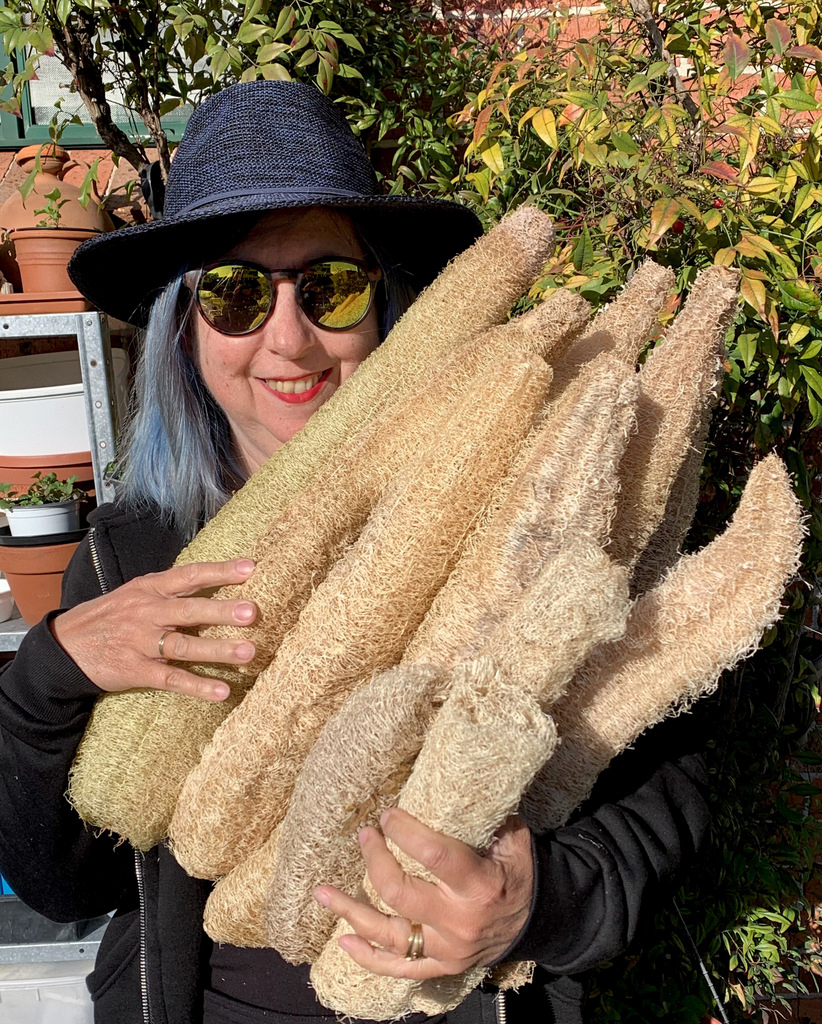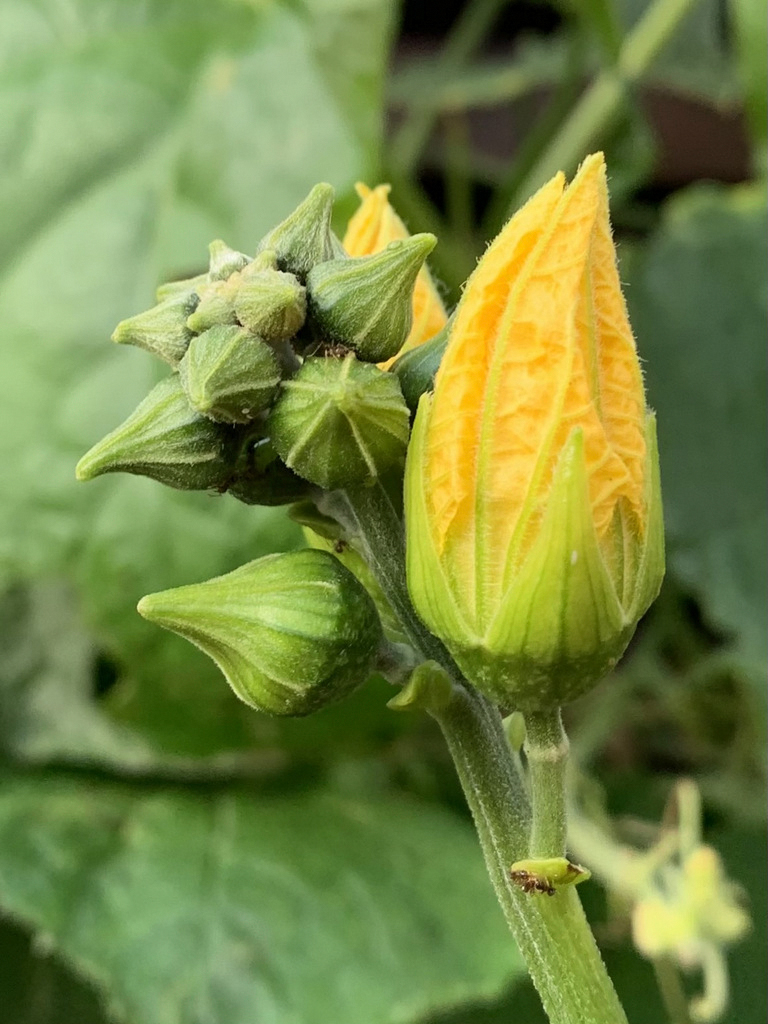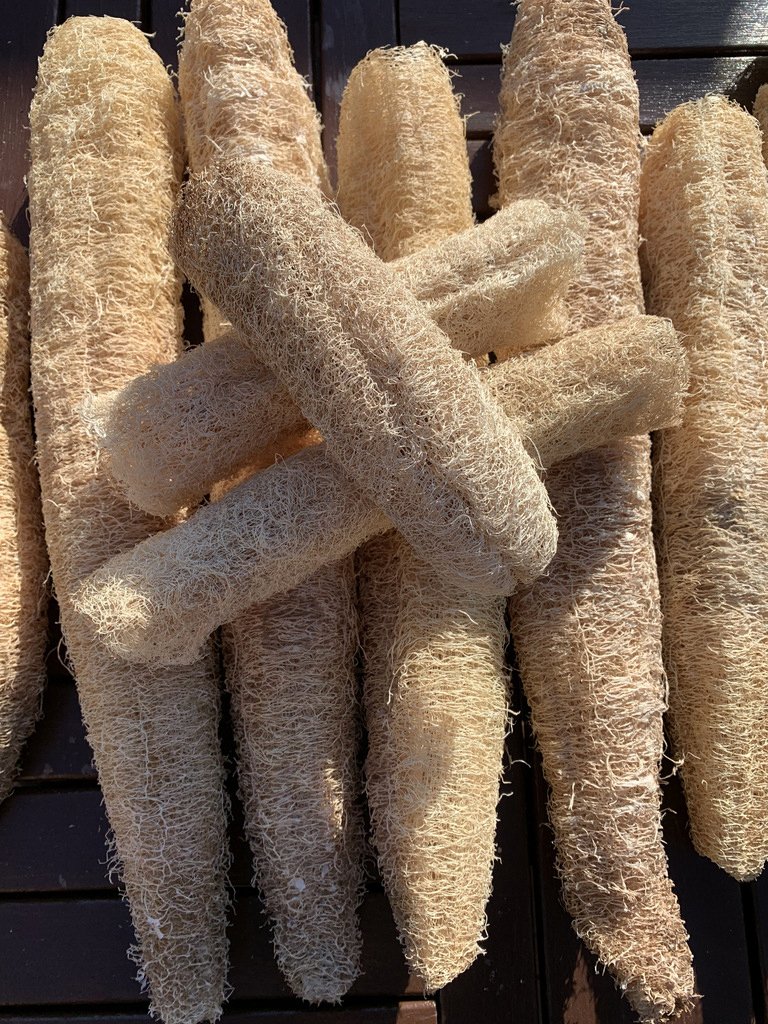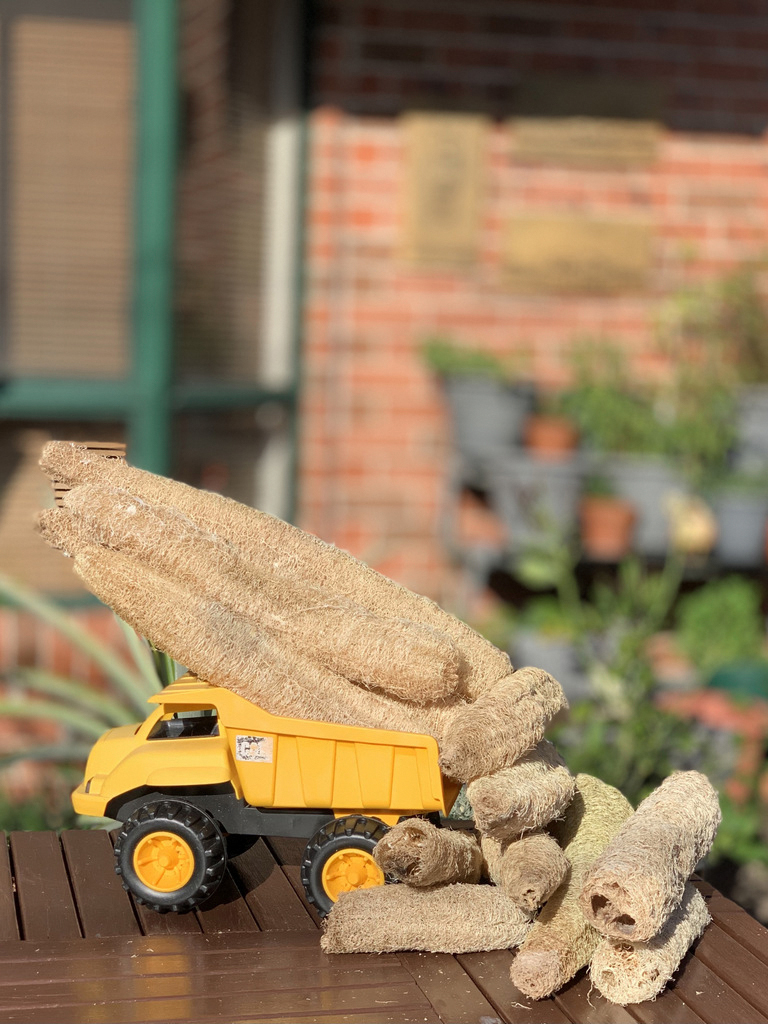You most likely know it as a back scrubber or a sponge. You may even think it comes from the sea. Loofah (luffa) is part of the cucumber family (Cucurbitaceae) and a fun, edible and sustainable vegetable to grow in your garden.

Loofah Harvest – Photo © The Gourmantic Garden
Growing loofah is an exercise in patience. In my temperate Sydney climate, I sowed seeds in August and the vine was still bearing fruit the following year in July. From one seed and one plant, I harvested over 25 sponges – another step towards self sufficiency and sustainability.
Here are my top 10 tips for growing loofah successfully and getting the most out of the climbing vine.
How to Grow Loofah / Luffa
1. Location

Loofah Vine – Photo © The Gourmantic Garden
Choose your location wisely. Loofah vines grow best in full sun. They occupy a lot of space and require a trellis for support and to climb on and spread out. In my courtyard garden, I grew it against a south facing wall that gets the sun in summer. The vine spread in both directions of the wall, then climbed up and wrapped itself all around the first floor balcony railing then further along the balcony door frame. I had to prune it to stop it from growing any further. What you see in the photo above is 1/10th of the size of the plant.
If you’re considering growing it in container, choose a large and deep container with 50cm diameter and more. Start training the vine up a sturdy trellis against a wall very early and make sure you have plenty of room for the vine to spread. The fruit is heavy while it’s green and needs support. Also, make sure you keep the soil moist and mulch well as it will dry out quickly in a container during summer. I haven’t tried growing loofahs in a container but this is the method I would use.
2. Soil Preparation
The soil needs to be free draining. Prep the soil before planting with plenty of organic matter, compost and blood and bone. In addition, I buried a length of seaweed next to the planting site after preparing “seaweed tea“. Every time I watered, I directed the water towards that spot to release nutrients.
3. Seed Preparation
Seeds require scarification before sowing. Use a nail file or sand paper to scratch the surface of the seed then soak it in water overnight before sowing.
4. Sowing

Loofah Flower – Photo © The Gourmantic Garden
To grow loofah, you can sow direct or raise seedlings in spring after the last frost date. I prefer to raise seedlings as it gives me more control and gives the seedlings a better chance of surviving once planted in the ground. Sow the seeds 15mm deep but no deeper as they need light to germinate. Keep the soil moist at all times. Germination is very slow and can take anything from 10-25 days. You may wish to sow more than one seed in the hole.
5. Transplant
If you’re raising seedlings, transplant once you have at least two sets of true leaves. If you’re growing more than one plant, space them 70 to 100cm apart.
6. Loofah Plant Maintenance

Overhanging Gourds – Photo © The Gourmantic Garden
Keep the plant well watered but not waterlogged and feed fortnightly with a liquid fertiliser. Train the tendrils early against the trellis in the desired direction to avoid a tangled mess. The vine requires very little maintenance otherwise and unlike other plants in the cucumber family, loofahs rarely get powdery mildew.
7. Loofah Flowers and Fruit

Loofah Male Flower Cluster – Photo © The Gourmantic Garden
The plant produces both male and female yellow flowers similar to zucchini. Male flowers grow in clusters as seen in the photo above.

The Female – Photo © The Gourmantic Garden
Female flowers are easily recognised by their ovary or mini fruit as per the photo above.
Loofah flowers are a bee magnet, and in my case, they’ve been an ant magnet. The ants took care of pollination and as such, hand pollination wasn’t required which is an advantage when they climb high. The plant produces fruit that starts by looking similar to a zucchini then grows much thicker and longer. The fruit needs 50 to 180 frost free days to reach maturity.
8. How to Harvest Loofah Gourds

Dry Gourd – Photo © The Gourmantic Garden
As the fruit fully ripens, the flesh becomes very fibrous. The skin turns brown and the fruit will be much lighter in weight. The skin can then be easily peeled to reveal the long-awaited loofah sponge. I recommend you watch my instagram reel on the loofah reveal. It comes with a great soundtrack ;)

Loofah Harvest – Photo © The Gourmantic Garden
As loofahs take a long time to fully mature, you may find yourself harvesting the gourds while they’re still green. This could be due to your climate or heavy rain or simply needing the space. They can be dried by the window sill but sometimes nature doesn’t play nice so follow these tried and tested steps for how to dry green loofah off the vine.
9. Seed Saving

Loofah Seeds – Photo © The Gourmantic Garden
Each loofah contains a lot of seeds which you would want to save, replant or share with others. I counted over 100 seeds from one loofah before I gave up. The easiest way to harvest seeds from a fully dried and peeled loofah is to shake it like you would shake a cocktail or bang it hard against a tray to dislodge the seeds.
The seeds are covered in chaff which should be removed before storage. I find crumbling them by hand dislodges the chaff which can further be removed by winnowing, which is gently blowing on the seeds to disperse the chaff.
10. Fun Facts

How to Grow Loofah / Luffa – Photo © The Gourmantic Garden
Fun Fact #1 – Loofahs are edible, much like zucchinis. They’re best eaten when they’re approximately 10 to 15cm long. However, I find the taste very bland and the texture a little dry.
Fun Fact #2 – Loofahs can be used in the kitchen and in the bath. They can be used to make melt and pour loofah soap which are a good gift idea.
Fun Fact #3 – The leaves of the loofah plant have a strange scent that’s very similar to peanut butter.
If you find this article useful, please let me know on @the.gourmanticgarden instagram page.
Let’s get growing and scrubbing!

